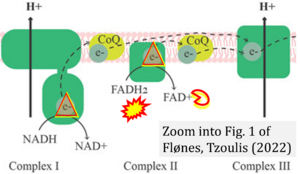Floenes 2022 Front Cell Dev Biol
| Flønes IH, Tzoulis C (2022) Mitochondrial respiratory chain dysfunction-a hallmark pathology of idiopathic Parkinson's disease? Front Cell Dev Biol 10:874596. https://doi.org/10.3389/fcell.2022.874596 |
Floenes IH, Tzoulis C (2022) Front Cell Dev Biol
Abstract: Parkinson's disease (PD) is the most common age-dependent neurodegenerative synucleinopathy. Loss of dopaminergic neurons of the substantia nigra pars compacta, together with region- and cell-specific aggregations of α -synuclein are considered main pathological hallmarks of PD, but its etiopathogenesis remains largely unknown. Mitochondrial dysfunction, in particular quantitative and/or functional deficiencies of the mitochondrial respiratory chain (MRC), has been associated with the disease. However, after decades of research in this field, the pervasiveness and anatomical extent of MRC dysfunction in PD remain largely unknown. Moreover, it is not known whether the observed MRC defects are pathogenic, compensatory responses, or secondary epiphenomena. In this perspective, we give an overview of current evidence for MRC dysfunction in PD, highlight pertinent knowledge gaps, and propose potential strategies for future research.
• Bioblast editor: Gnaiger E
Correction: FADH2 and Complex II
- FADH2 is shown as the substrate feeding electrons into Complex II (CII). This is wrong and requires correction - for details see Gnaiger (2024).
- Gnaiger E (2024) Complex II ambiguities ― FADH2 in the electron transfer system. J Biol Chem 300:105470. https://doi.org/10.1016/j.jbc.2023.105470 - »Bioblast link«
Hydrogen ion ambiguities in the electron transfer system
Communicated by Gnaiger E (2023-10-08) last update 2023-11-10
- Electron (e-) transfer linked to hydrogen ion (hydron; H+) transfer is a fundamental concept in the field of bioenergetics, critical for understanding redox-coupled energy transformations.
- However, the current literature contains inconsistencies regarding H+ formation on the negative side of bioenergetic membranes, such as the matrix side of the mitochondrial inner membrane, when NADH is oxidized during oxidative phosphorylation (OXPHOS). Ambiguities arise when examining the oxidation of NADH by respiratory Complex I or succinate by Complex II.
- Oxidation of NADH or succinate involves a two-electron transfer of 2{H++e-} to FMN or FAD, respectively. Figures indicating a single electron e- transferred from NADH or succinate lack accuracy.
- The oxidized NAD+ is distinguished from NAD indicating nicotinamide adenine dinucleotide independent of oxidation state.
- NADH + H+ → NAD+ +2{H++e-} is the oxidation half-reaction in this H+-linked electron transfer represented as 2{H++e-} (Gnaiger 2023). Putative H+ formation shown as NADH → NAD+ + H+ conflicts with chemiosmotic coupling stoichiometries between H+ translocation across the coupling membrane and electron transfer to oxygen. Ensuring clarity in this complex field is imperative to tackle the apparent ambiguity crisis and prevent confusion, particularly in light of the increasing number of interdisciplinary publications on bioenergetics concerning diagnostic and clinical applications of OXPHOS analysis.
Labels: Pathology: Parkinson's




